14 River Rock Landscaping Ideas for Modern and Durable Garden Designs
River rock landscaping offers a simple and natural way to enhance outdoor spaces. Its smooth texture and variety of colors make it a popular choice for gardens and yards. Many people use river rocks to add both beauty and practical features to their landscaping.

The value of river rock lies in its versatility to create lasting, attractive designs that work in many settings. From borders to pathways, river rock can fit different styles and needs without much maintenance. This collection of ideas helps homeowners find easy ways to upgrade their yards with river rocks.
1) Create a decorative border using small or medium river rocks to define garden beds.
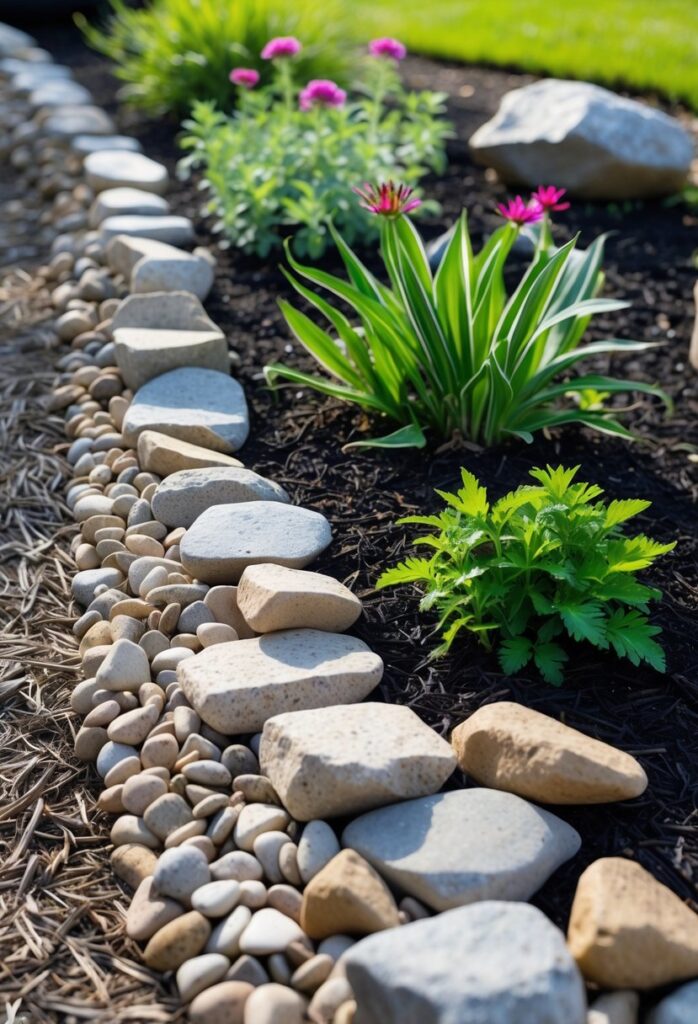
Using small or medium river rocks to edge garden beds is a simple way to add structure and style. It clearly marks the area where plants grow, giving the garden a neat and organized look.
First, the area along the garden bed edge should be cleared of weeds and debris. A weed barrier fabric can be laid down to stop weeds from growing through the rocks. Then, an edging border helps keep the rocks in place.
After that, the river rocks are spread evenly along the edge. Their smooth, natural look works well with many garden styles. Using different sizes or colors of rocks can add visual interest.
This type of border is low maintenance, as river rocks do not break down like mulch. It also helps control grass from creeping into garden beds.
For more tips on creating effective river rock borders, see how to make a low-maintenance stone border.
2) Design a natural pathway with stepping stones set among river rocks.

Creating a pathway using stepping stones placed among river rocks adds both function and style to outdoor spaces. The stones provide stable footing, while the river rocks fill in gaps for a natural, polished look. This combination works well for gardens, yards, or poolside areas.
To build the path, start by laying landscaping fabric to prevent weeds. Next, set the stepping stones in the desired pattern. Then, fill the spaces around the stones with a mix of river rock sizes and colors. This mix enhances the natural feel and helps keep the stones in place.
Using larger stepping stones is helpful for frequently used pathways and areas where people walk barefoot. The river rocks should be spread evenly to create a smooth surface, stopping just below the edge of the stones to avoid overflow. This design guides visitors and highlights the surrounding garden features. For more details on ideas and steps, see 21 modern river rock landscaping ideas.
3) Build a river rock dry creek bed for excellent drainage and visual interest
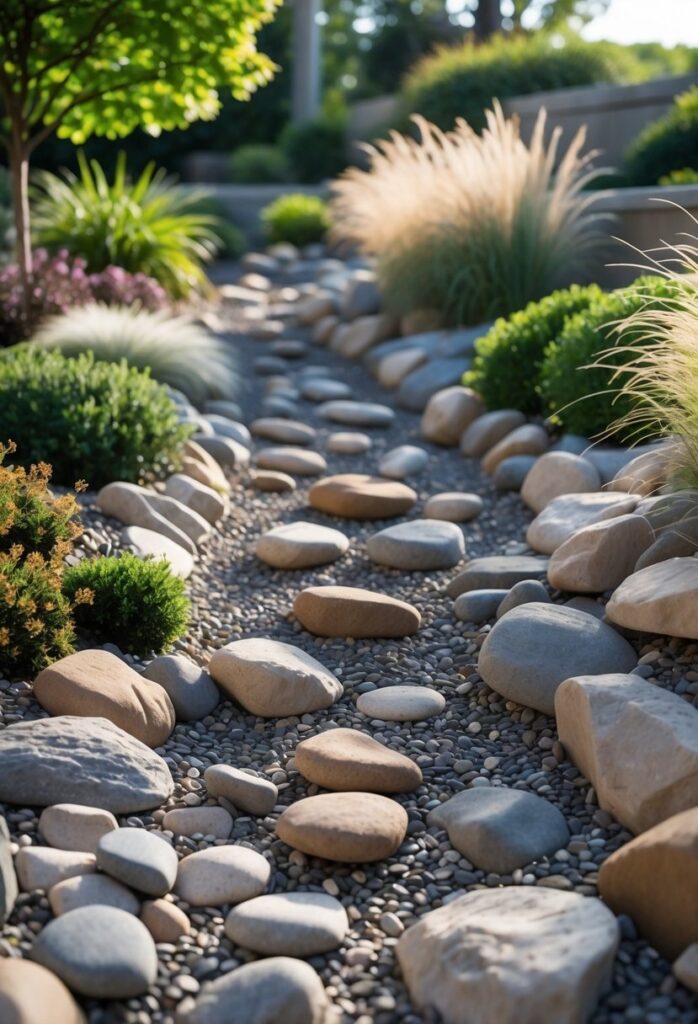
A river rock dry creek bed is a practical way to control water drainage in a yard. It helps direct rainwater away from areas that gather puddles or cause erosion. This method works well on sloped landscapes or near downspouts.
Using a mix of large boulders, medium river rocks, and smaller gravel creates a natural look. The larger rocks add structure while the smaller stones fill in the center, mimicking a real creek bed. This also helps guide water smoothly through the channel.
Besides drainage, a dry creek bed adds visual appeal by breaking up flat landscapes. Plants and grasses along the edges can soften the rocks and blend the feature into the garden. With proper planning and layering, it requires little maintenance.
Building one starts with digging a shallow trench where water naturally flows. Next, lining the trench with landscape fabric prevents weeds. Then, stones are carefully placed to create a balanced pattern that looks like a dry stream. For detailed tips, see 14 Dry River Bed Landscape Ideas That Add Style to Your Yard.
4) Use river rocks to edge patios and prevent grass spreading
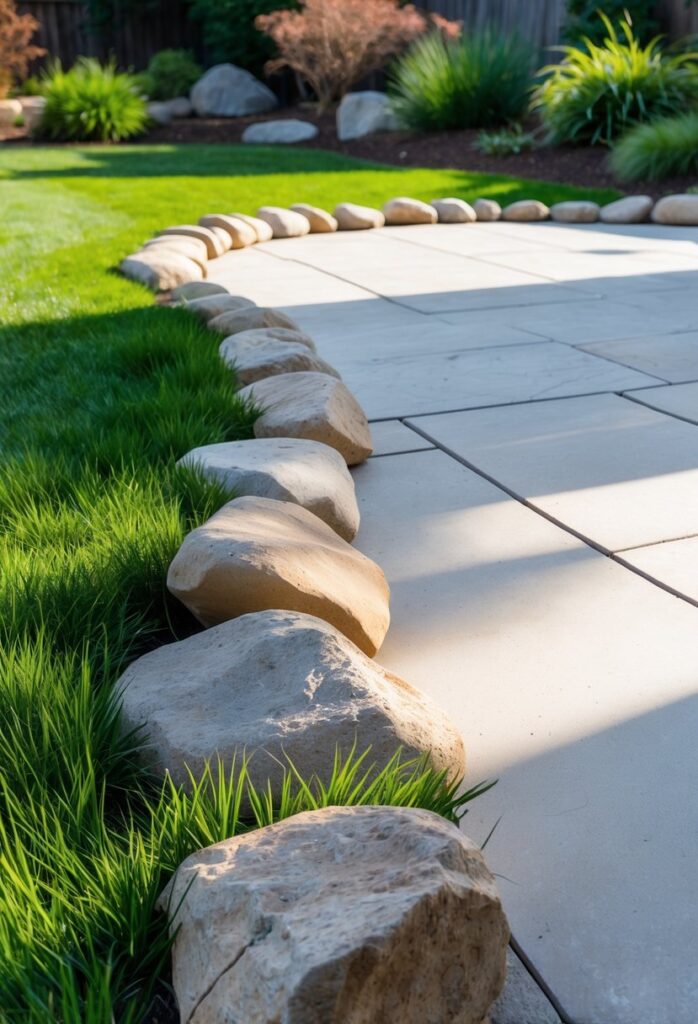
River rocks create a clean and natural border around patios. This edging helps keep grass and weeds from growing into the patio area. Using smaller or medium-sized river rocks makes the edge look neat and well-defined.
The rocks also add texture and contrast to the hard surface of the patio. They protect the patio edges from damage caused by lawn equipment, like mowers and trimmers. This keeps the space looking tidy for longer.
To install, place the river rocks in a narrow trench along the patio border. Start with smaller rocks near the edge and layer larger ones behind for stability. This method is both functional and attractive for outdoor spaces.
For more ideas on using river rocks for edging and garden borders, see 25 river rock edging ideas for your garden.
5) Combine river rocks with mulch for a low-maintenance yet stylish ground cover

Combining river rocks with mulch creates an attractive ground cover that balances style and ease of care. The rocks add texture and weight, while mulch offers color and organic benefits. This mix reduces the amount of mulch needed, which can save time during seasonal replacement.
This blend also helps with moisture retention in soil and prevents weed growth. River rocks are durable and allow water to pass through easily. Mulch breaks down over time, improving soil health naturally.
Using both materials lets homeowners design pathways, flower beds, or borders with clear contrasts. The combination works well with many plant types and garden styles. It offers a neat, polished look without demanding much upkeep.
For more ideas on mixing mulch and river rock landscaping, see this guide on mulch and river rock landscaping ideas that focuses on practical and stylish options.
6) Incorporate river rocks around a water feature to enhance natural aesthetics.

Using river rocks around a water feature adds a natural and calming look to the space. The smooth, rounded stones blend well with water, making the area feel more organic. They can frame ponds, fountains, or waterfalls to create a seamless transition between water and land.
River rocks also help control erosion by keeping soil in place near the water. Their varied colors and sizes add texture and interest without needing much maintenance. This makes them ideal for enhancing the visual appeal without extra work.
Placing river rocks around the edges of water features can soften harsh lines. It also improves drainage by allowing water to flow through gaps between the stones. This prevents puddles and keeps the area looking clean.
For a more authentic look, layering river rocks with plants creates a balanced design. Grasses and native flowers among the stones add contrast and color, boosting the natural feel of the water feature.
To learn more about decorating with river rocks near water, see river rock landscaping ideas.
7) Craft a zen garden with smooth river rocks for a tranquil outdoor space.
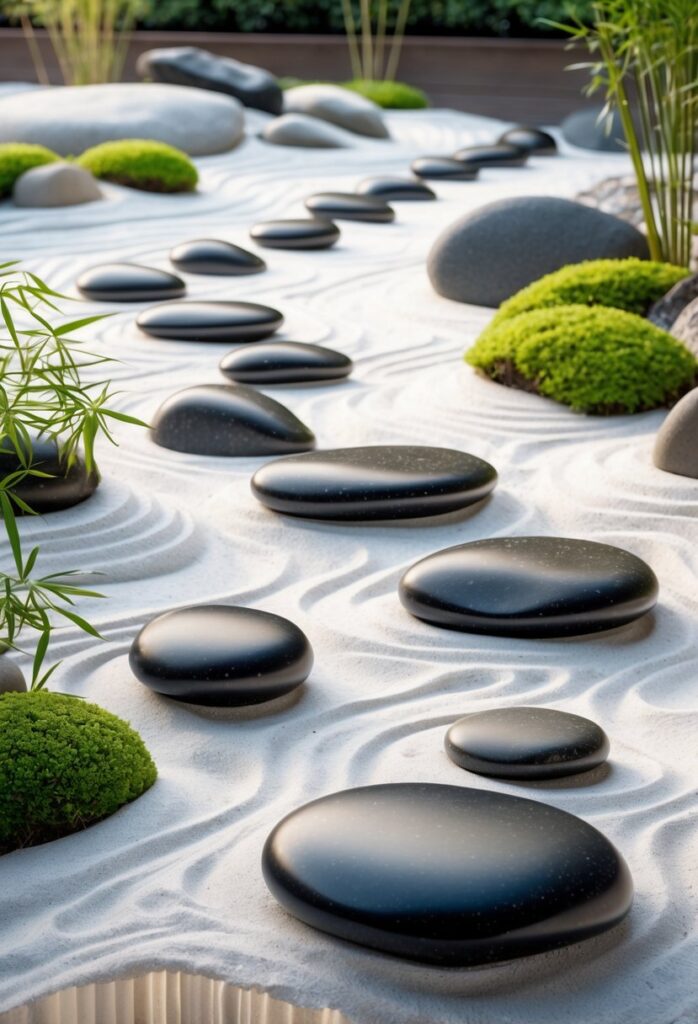
Using smooth river rocks in a zen garden helps create a calm and peaceful environment. These stones add natural texture and balance without needing much maintenance. They can be arranged around sand or gravel to form simple, clean patterns.
The gentle shapes and colors of river rocks encourage quiet reflection. They work well with other elements like moss, small plants, or wooden features to enhance the feeling of harmony. A rake can be used to shape the sand around the rocks, adding to the overall design.
This type of garden supports mindfulness by offering a visually soothing place outside. It’s easy to customize based on space and style preferences. Smooth river rocks are also durable and weather well, making them a practical choice for an outdoor zen space.
For ideas on using river rocks in tranquil settings, see 30 Stunning River Rock Landscaping Ideas for a Beautiful Garden.
8) Line a front porch planter bed with river rocks to boost curb appeal.
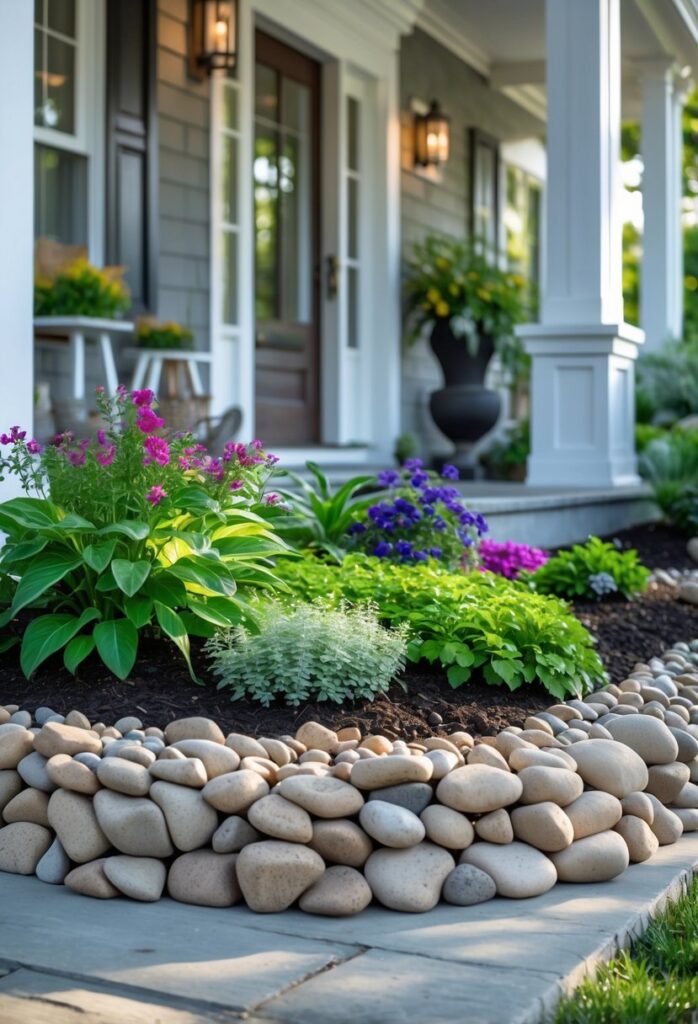
Using river rocks to line a front porch planter bed adds a clean, polished look. The smooth texture of the rocks contrasts nicely with bright flowers or green plants. This simple change helps define the space and keeps soil or mulch contained.
River rocks are low maintenance and durable, so they hold up well in different weather. They don’t need frequent replacement like mulch does. This makes them a practical choice for busy homeowners who want curb appeal without extra work.
Choosing river rocks in neutral or natural colors blends well with most house styles. It creates a balanced look that highlights the plants without overwhelming the area. Lining the planter bed with river rocks is an easy way to improve the entrance’s appearance and make the front porch more inviting.
For design ideas and tips on using this approach, see examples of front porch river rock landscaping to boost curb appeal.
9) Create seating areas surrounded by river rock accents for texture and durability.
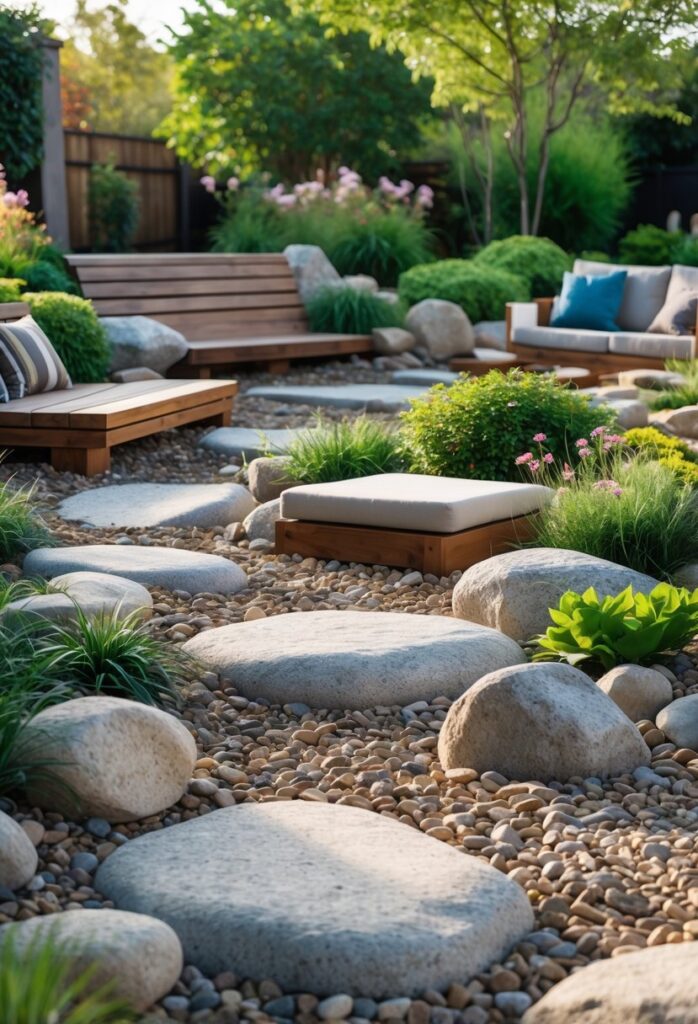
Seating areas framed by river rock offer both style and function. The rocks add a natural texture that contrasts well with wood or metal furniture. This combination makes outdoor spaces feel grounded and inviting.
Using larger river stones as borders around the seating zone creates clear boundaries. It also helps keep mulch or soil from shifting into the area. These rocks are durable and withstand weather, so they need little upkeep.
People can also build benches or low walls with river rocks. These features blend smoothly into gardens and patios. Adding cushions or colorful plants nearby softens the look and boosts comfort.
For a rustic touch, laying river rocks under chairs or tables creates a rough, natural floor. This base is sturdy and handles foot traffic without damage. Lighting around the rocks enhances the area’s ambiance at night.
This design is practical and attractive, making seating spaces more unique with natural stone elements. It suits many styles, from rustic to modern. For more ideas, see river rock patio ideas.
10) Use larger river rocks as focal points or sculptures in the landscape
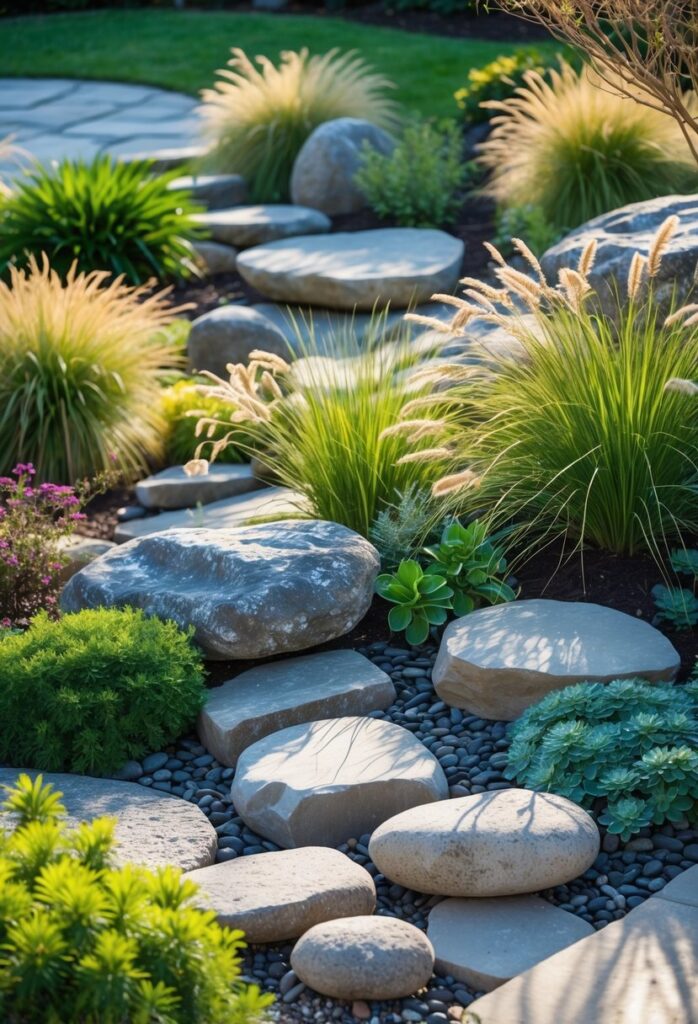
Larger river rocks work well as natural focal points in a garden. They draw attention and add a sense of structure to the space. Placing one or more big stones near plants or pathways creates a strong visual anchor.
Some people stack river rocks to make simple sculptures. These rock formations add interest without needing much maintenance. They also bring an artistic touch to the yard.
Using large rocks contrasts nicely with softer plants and smaller stones. This mix of textures helps balance the landscape design. Flat stones can be added to create functional stepping areas within the rock arrangement.
This approach is low-maintenance and durable. It suits gardens aiming for a natural, organic feel. For more ideas on using river rock in landscaping, see creative river rock landscaping.
11) Integrate river rocks into rock gardens with drought-tolerant plants

River rocks add a natural and polished look to rock gardens. They come in different sizes and colors, offering variety without much maintenance.
Pairing river rocks with drought-tolerant plants creates a landscape that uses less water. Plants like succulents, Russian sage, and blue oatgrass thrive in dry conditions with little care.
The rocks help keep soil moist by reducing evaporation. They also provide good drainage, which prevents plant roots from staying too wet.
Combining river rocks and dry-loving plants creates a balanced, sustainable garden. This design works well in areas where water is limited. It keeps the yard attractive year-round without much effort.
Using this mix can reduce the need for watering and lawn mowing. For more ideas on matching rocks with plants, see river rock landscaping with drought-tolerant options.
12) Construct a fire pit outline using tightly packed river rocks.

They start by choosing smooth, round river rocks that fit well together. The rocks should be about the same size to create a stable fire pit edge.
Next, they clear and level the ground where the fire pit will go. A flat base helps keep the rocks steady and safe during use.
The rocks are then placed tightly around the fire pit area. Packing them close prevents gaps that could allow heat to escape or cause shifting.
Using river rocks for the outline adds a natural look to the fire pit. It also provides a durable border that can handle heat and outdoor conditions well.
For best results, they may use a level to check evenness. This keeps the fire pit rim smooth and comfortable to sit near.
More details on building a river rock fire pit are available in this video tutorial.
13) Ring tree bases with river rocks to protect roots and add contrast.

Ringing tree bases with river rocks can help protect tree roots from damage. The rocks create a barrier that reduces soil erosion and keeps the roots safe from foot traffic or lawn equipment.
This method also helps retain soil moisture. By holding water near the roots, river rocks support healthier tree growth during dry periods.
River rocks add a clean, natural look around trees. Their smooth shapes and varied colors create a pleasing contrast with green leaves and bark.
Using landscape fabric under the rocks can prevent weed growth. This keeps the area tidy without harming the tree roots.
Care should be taken not to pile rocks too high or close to the trunk. This prevents moisture buildup that could cause root rot or bark damage.
This simple addition can improve the appearance and health of trees in yards or gardens. For more ideas on using river rocks in landscaping, see Landscaping Around Trees with Rocks | Design Tips & Root Safety.
14) Scatter river rocks to fill gaps between stepping stones for stability.
Filling gaps between stepping stones with river rocks adds both function and style. The scattered rocks help keep the stones in place, reducing movement when walked on. This creates a safer and more stable pathway.
The rocks also prevent soil erosion around the stones. This keeps the area neat and reduces maintenance over time. Using different sizes and colors of river rocks can add a natural and attractive look to the path.
Laying a layer of landscaping fabric underneath stops weeds from growing through the rocks. It also improves drainage, preventing puddles from forming on the path. This simple step makes the pathway last longer and stay clean.
This method works well for garden walkways, patios, or any outdoor path. It blends naturally with plants and other landscaping features. Filling gaps with river rocks makes a functional walkway look finished and polished. More ideas and tips on this can be found in river rock landscaping ideas at https://mrplanter.com/river-rock-landscaping-ideas/.
Fundamentals of River Rock Landscaping
River rock landscaping uses smooth, rounded stones to create attractive outdoor spaces that require little upkeep. Understanding the benefits and how to select the right size and color helps make the most of these stones in garden design.
Benefits of Using River Rocks Outdoors
River rocks provide durability and low maintenance. They do not break down like mulch and resist erosion, making them ideal for pathways and garden beds.
These stones improve drainage by allowing water to flow through spaces between them. This reduces soil erosion and prevents water pooling.
River rocks also add a natural look and texture to landscapes. Their smooth shapes contrast well with plants and other materials without needing frequent replacement.
Another key benefit is their ability to withstand harsh weather. They don’t fade easily in sunlight or wash away in heavy rain, which keeps outdoor areas looking neat year-round.
Choosing the Right Size and Color
The size of river rocks affects both appearance and function. Large rocks (2-4 inches) are good for borders and pathways. Smaller rocks (1 inch or less) work well for ground cover and flower beds.
Color choice should complement other landscape elements like plants, mulch, or hardscaping. Neutral shades like gray or tan blend naturally, while mixed colors can highlight different garden zones.
Grouping rocks in various sizes and colors creates depth and interest. Avoid using too many colors at once to keep a cohesive look.
Selecting rocks that fit the existing landscape helps enhance curb appeal and supports desired garden functions like edging, drainage, or decoration. For more ideas on how to pick the right river rock, see 14 backyard river rock ideas for natural appeal.
Maintenance and Care Tips
Keeping river rock landscaping looking neat takes effort, but it mainly involves controlling weeds and cleaning the rocks without harsh chemicals. Proper steps help maintain the rock’s smooth, natural appearance over time.
Preventing Weed Growth
Weeds often grow between river rocks, which can ruin the clean look. Installing a thick weed barrier fabric under the rocks is one of the most effective ways to stop them from sprouting. It limits sunlight and blocks roots.
Regularly raking the rocks helps disturb small weed seeds before they take root. Using a pre-emergent weed killer once or twice a year can reduce seed germination without harming the stones.
Removing weeds by hand as soon as they appear also prevents them from spreading. Checking for areas where soil or mulch gathers is key because those spots invite weed growth. Keeping rocks evenly spread and free of debris helps with this.
Eco-Friendly Cleaning Solutions
Cleaning river rocks without damaging the environment is important. Using plain water and a stiff broom or brush is often enough to remove dirt and algae.
For tougher stains, a mixture of white vinegar and water (one part vinegar to four parts water) can be sprayed on, then rinsed off after 10–15 minutes. This solution helps break down organic buildup without toxins.
Avoid harsh chemical cleaners that can harm plants or soil life around the rocks. Regular maintenance, like sweeping and rinsing, reduces the need for stronger cleaners and keeps the area looking fresh year-round.
Cleaning should be done gently to avoid moving or damaging the rock layout.
Frequently Asked Questions
River rocks can serve many purposes, from improving drainage to adding natural beauty. They work well in both large and small spaces and can be paired with other materials for functional and visual benefits.
How can I incorporate river rock into my low-maintenance landscaping plans?
River rocks need little upkeep and resist weather damage. Using them as ground cover or in dry creek beds helps reduce watering and weeding. Edging garden beds or patios with river rocks also limits grass growth and keeps the area tidy.
What are some creative ways to use river rock in small garden spaces?
In small gardens, river rocks can create decorative borders that define planting areas. Adding a natural pathway or placing stepping stones among the rocks adds movement without taking up much space. Small and medium-sized rocks work best for these uses.
What are the benefits and downsides of using river rock in landscaping projects?
Benefits include durability, low maintenance, good drainage, and natural aesthetic appeal. Downsides may include heat retention in hot climates and the potential for rocks to shift if not properly installed. Careful planning can minimize these issues.
Can river rock be combined with mulch for aesthetic and functional landscaping benefits?
Yes. Mulch paired with river rocks offers a stylish and practical ground cover. Mulch helps retain soil moisture, while rocks prevent weed growth and improve soil drainage. Together, they create a balanced look and easier maintenance.
What are some examples of river rock being used in front yard designs?
River rocks can frame walkways or driveways, adding texture and contrast. They are also used to build dry creek beds for drainage or as borders around garden beds to keep lawns from spreading. These elements enhance curb appeal with natural charm.
What design tips should be considered when using large river rocks in landscaping?
Large river rocks work as focal points or natural seating in yards. Place them where they won’t obstruct movement and anchor them securely to prevent shifting. Mixing sizes and shapes helps create a more natural, balanced look.
